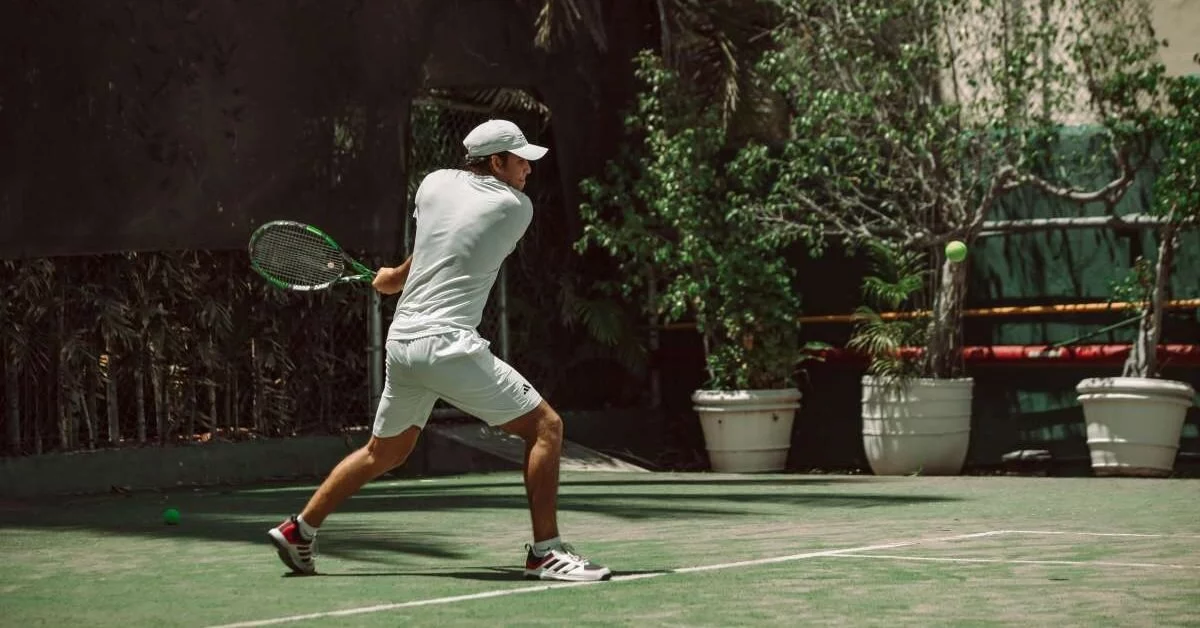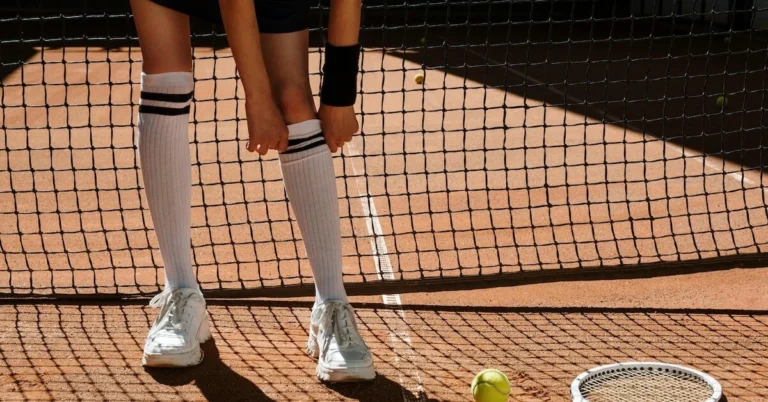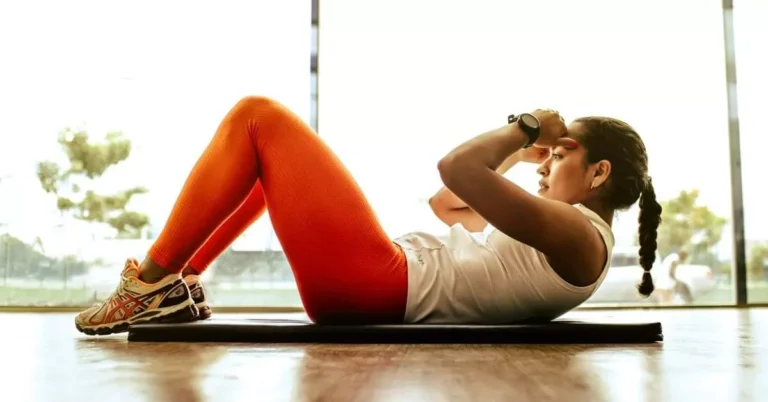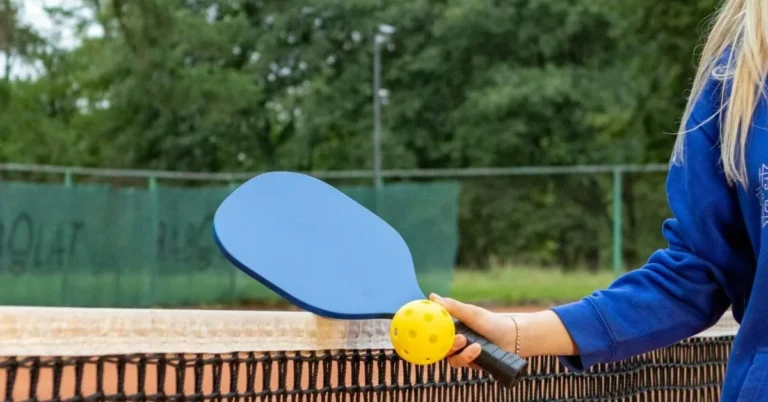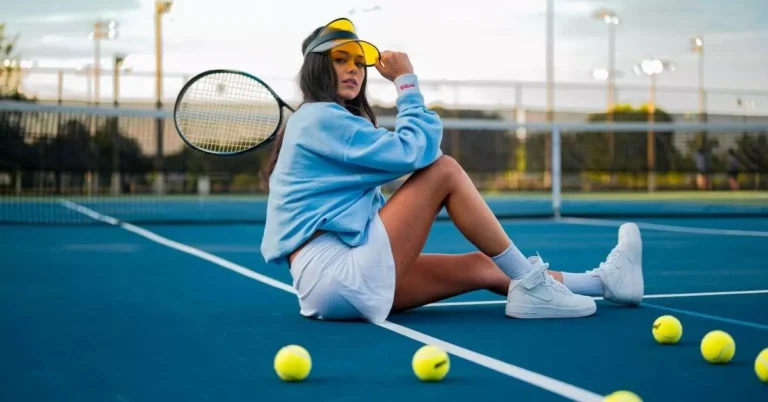If you’re looking to improve your tennis game, mastering the backhand volley in tennis is an essential skill to have. The backhand volley is a shot that requires a combination of technique, footwork, and timing. In this article, we’ll cover the basics of how to hit a backhand volley and provide some tips to help you improve your technique.
The backhand volley in tennis is a shot that is hit while standing at the net, usually in response to a low ball hit by the opponent. It’s a shot that requires a lot of control and finesse, as well as the ability to generate power when needed. To hit a backhand volley in tennis, you’ll need to have a solid grip on the racket, good footwork, and a proper understanding of the technique involved.
Whether you’re a beginner or an experienced player, mastering the backhand volley can take some time and practice. However, with the right approach and some dedication, you can improve your technique and take your tennis game to the next level. In the following sections, we’ll provide some tips and techniques to help you hit a better backhand volley.
Pro:
✅ best all-rounder ✅ stability ✅ high support
Con:
❌ maybe you need some time to get used to it
Understanding the Backhand Volley in Tennis
The backhand volley in tennis is a crucial shot that can make the difference between winning and losing a point. It is a shot that is performed at the net, and it requires good technique and timing. In this section, you will learn about the backhand volley in tennis, its importance, and how to execute it correctly.
Importance of the Backhand Volley
The backhand volley is a shot that is used to finish off points at the net. It is an offensive shot that can put your opponent on the defensive. Having a good backhand volley can also help you to cover more of the court and make it harder for your opponent to pass you at the net.
How to Execute the Backhand Volley
To execute a backhand volley in tennis, you need to have good footwork and positioning. Start by moving towards the net with small steps, keeping your knees slightly bent and your weight on the balls of your feet. When the ball comes towards you, take a small step towards it and turn your body slightly sideways.
As you make contact with the ball, keep your wrist firm and your racket head up. Use a short backswing and a quick follow-through to generate power and control. Aim to hit the ball in front of your body and towards the open court.
Common Mistakes to Avoid
One common mistake when hitting a backhand volley in tennis is to use too much wrist. This can cause you to lose control of the shot and hit the ball out of bounds. Another mistake is to take your eye off the ball too soon. This can cause you to miss the ball or hit it too weakly.
To avoid these mistakes, focus on keeping your wrist firm and your eyes on the ball. Practice your footwork and positioning so that you can move quickly and get into the right position to hit the ball. With practice, you will be able to hit a strong and accurate backhand volley every time.
Grip and Preparation
Choosing the Right Grip
The grip is an essential factor that determines the success of your backhand volley in tennis. The grip you choose should be comfortable and allow you to have control over the racket. One of the most popular grips used by players is the continental grip. This grip enables you to have a firm grip on the racket, which is essential when hitting a backhand volley in tennis.
To achieve the continental grip, hold the racket with your non-dominant hand and place the base knuckle of your index finger on the third bevel of the racket handle. Then, slide your hand down the handle, and your thumb should be placed against the back of the handle. This grip will allow you to have a more natural swing and better control over the racket.
Preparation for the Shot
Before hitting a backhand volley, you need to prepare yourself for the shot. Your body position should be in a semi-open stance, with your feet shoulder-width apart. Your knees should be slightly bent, and your weight should be evenly distributed on both feet.
Next, you need to prepare your racket. Hold the racket with your continental grip, and keep it in front of your body. Your racket head should be just above your wrist, and your elbow should be close to your body. This will allow you to have better control over the racket and increase your accuracy when hitting the ball.
By choosing the right grip and preparing yourself for the shot, you’ll be able to hit a backhand volley in tennis with more confidence and precision. Remember to practice your grip and preparation to improve your backhand volley technique.
Executing the Backhand Volley in Tennis
To execute a successful backhand volley, you need to focus on three key elements: Contact Point, Swing Path, and Follow Through. Let’s dive into each of these elements in more detail.
| Contact Point | The contact point is the most critical aspect of hitting a backhand volley. You should aim to make contact with the ball in front of your body, preferably around waist height. This position allows you to generate more power and control over the shot. Keep your wrist firm and your racquet face open to achieve a solid, clean contact with the ball. |
| Swing Path | The swing path for a backhand volley in tennis is relatively short and compact. You don’t need to take a big backswing to execute this shot. Instead, focus on keeping your racquet face open and your wrist firm. As the ball approaches you, bring your racquet forward in a straight line towards the contact point. Make sure to keep your elbow close to your body to maintain stability and control. |
| Follow Through | The follow-through on a backhand volley in tennis is relatively short and straightforward. Once you make contact with the ball, continue to bring your racquet forward in a straight line towards your target. Your racquet should finish pointing towards your target, and your body should be balanced and ready for the next shot. |
When executing a backhand volley in tennis, you can either hit a shot or block the ball back. The shot is more aggressive and requires more power, while the block is more defensive and requires less power. Choose the right technique based on the situation and your opponent’s shot.
Footwork and Body Position
To hit a successful backhand volley in tennis, you need to have proper footwork and body position. In this section, we will cover the key elements of footwork and body position that will help you execute a solid backhand volley.
The Split Step
The split step is an essential component of footwork that helps you move quickly and efficiently to the ball. As your opponent hits the ball, you should take a small hop and land with your feet about shoulder-width apart. This will help you maintain balance and prepare for the next shot.
Balance and Stability
Staying balanced and stable is crucial when hitting a backhand volley in tennis. You should keep your weight on the balls of your feet and maintain a slight bend in your knees. This will help you stay low and maintain stability as you move to the ball. It’s also important to keep your head still and your eyes on the ball to maintain good balance.
Body Momentum
Using your body momentum is key to hitting a powerful backhand volley. As you move to the ball, you should transfer your weight from your back foot to your front foot. This will help you generate more power and control as you hit the ball. It’s important to keep your body moving forward as you hit the ball to maintain momentum and control.
By mastering these elements of footwork and body position, you can improve your backhand volley in tennis and become a more well-rounded player. Remember to stay balanced, use your body momentum, and always be ready to split step. With practice and dedication, you can take your backhand volley to the next level.
One-Handed vs Two-Handed Backhand Volley in Tennis
If you’re looking to improve your backhand volley in tennis, one of the first decisions you’ll need to make is whether to use a one-handed or two-handed grip. Both techniques have their advantages and disadvantages, so it’s important to understand the differences before making a decision.
One-Handed Backhand Volley
The one-handed backhand volley is a classic technique that has been used by some of the greatest players in history. It’s a versatile grip that can be used in a variety of situations, and it allows for greater reach and flexibility than a two-handed grip.
To execute the one-handed backhand volley, you’ll need to grip the racquet with your dominant hand and use your non-dominant hand for support. This grip allows you to use your wrist and arm to generate power and spin, giving you greater control over your shots.
However, the one-handed backhand volley in tennis requires a lot of practice and skill to master. It can be difficult to generate enough power with just one hand, and it can be challenging to maintain control of the racquet while moving quickly around the court.
Two-Handed Backhand Volley
The two-handed backhand volley is a newer technique that has become increasingly popular in recent years. It’s a more stable grip that allows for greater control and consistency, especially when hitting low volleys or dealing with difficult shots.
To execute the two-handed backhand volley in tennis, you’ll need to grip the racquet with both hands, using your non-dominant hand for support. This grip allows you to use your body and legs to generate power and stability, giving you greater control over your shots.
However, the two-handed backhand volley can be less versatile than the one-handed grip, and it can be more difficult to reach high volleys or make quick adjustments on the court. Additionally, if you hit a forehand volley with a weak Eastern grip, the two-handed grip might not be the best option.
Ultimately, the choice between a one-handed or two-handed backhand volley in tennis will depend on your personal preference and playing style. If you’re looking for greater reach and flexibility, the one-handed grip might be the better option. If you’re looking for greater control and consistency, the two-handed grip might be the better option.
Advanced Techniques and Tactics
The Half Volley
The half volley is a difficult shot to master but can be a great weapon in your arsenal. It involves hitting the ball just after it bounces off the ground, which requires quick reflexes and good timing. To execute the half volley, you need to be in a low position with your knees bent and your weight forward. Keep your racket head up and your eyes on the ball. Use a short backswing and a firm wrist to punch the ball back over the net.
The Swinging Volley
The swinging volley is a powerful shot that requires good footwork, timing, and technique. It is hit in the air and is similar to a groundstroke. To execute the swinging volley, you need to move quickly to get into position, turn your shoulders and hips, and use a full backswing. Make contact with the ball at the highest point and follow through with your racket head. This shot can be used to put away short balls or attack your opponent’s weaker side.
The Drop Shot
The drop shot is a great way to surprise your opponent and change the pace of the game. It involves hitting the ball softly over the net and landing it just inside the service line. To execute the drop shot, you need to use a short backswing and a gentle touch. Keep your wrist loose and your racket head open. This shot can be used to draw your opponent to the net or force them to run forward and retrieve the ball.
When playing at the net, it’s important to be aggressive and take control of the point. Use your volleys to put pressure on your opponent and force them to make errors. Try to keep your volleys low and deep to make it difficult for your opponent to return them. Use a combination of low volleys, half volleys, and swinging volleys to keep your opponent guessing. Vary the pace and spin of your shots to make it difficult for your opponent to anticipate your next move.
In addition to mastering the different types of volleys, it’s important to have a good understanding of tactics. Use your volleys to set up your next shot or to finish off the point. If your opponent is standing too far back, try hitting a short drop shot to draw them forward. If they are crowding the net, try hitting a lob to force them back. Be patient and wait for the right opportunity to attack. With practice and dedication, you can become a master of the backhand volley in tennis.
Improving Your Backhand Volley in Tennis
In this section, we’ll cover some practice drills and common mistakes and corrections that will help you improve your backhand volley in tennis.
Practice Drills
Practice is key to improving your backhand volley in tennis. Here are 3 drills you can do to help you get better:
- Wall practice: Stand facing a wall and hit the ball against it with your backhand. This will help you develop your timing and accuracy.
- Partner practice: Find a partner and practice hitting backhand volleys to each other. This will help you develop your footwork, timing, and control.
- Shadow practice: Stand in front of a mirror and practice your backhand volley without a ball. This will help you perfect your technique and form.
5 Common Mistakes and Corrections
Here are 5 common mistakes that people make when hitting a backhand volley, and how to correct them:
| Mistake | Not keeping your eye on the ball. | Correction | Keep your eye on the ball at all times, and watch it all the way onto your racket. |
| Mistake | Not using the proper grip. | Correction | Use a continental grip for your backhand volley. |
| Mistake | Not using your legs. | Correction | Use your legs to get in position and generate power. |
| Mistake | Not following through. | Correction | Follow through with your racket after hitting the ball to ensure proper form and power. |
| Mistake | Not practicing enough. | Correction | Practice your backhand volley regularly to improve your technique, timing, and control. |
By incorporating these practice drills and correcting common mistakes, you can improve your backhand volley and become a more well-rounded tennis player.
Famous Backhand Volley in Tennis History
When it comes to backhand volleys, there are a few players that immediately come to mind. In this section, we’ll take a closer look at two of the most famous backhand volleys in tennis history: Pete Sampras’ and Roger Federer’s.
Pete Sampras’ Backhand Volley
Pete Sampras was known for his incredible serve and volley game, and his backhand volley was a key part of his success. Sampras had a very compact and efficient backhand volley, which allowed him to quickly and accurately put away any ball that came his way.
One of the keys to Sampras’ backhand volley was his footwork. He was always in position to hit the ball, and he had a great sense of timing that allowed him to make contact with the ball at just the right moment. Sampras was also very good at disguising his backhand volley, which made it difficult for his opponents to anticipate where he was going to hit the ball.
Roger Federer’s Backhand Volley
Roger Federer is widely regarded as one of the greatest tennis players of all time, and his backhand volley is a big reason why. Federer’s backhand volley is smooth, effortless, and incredibly effective.
One of the things that makes Federer’s backhand volley so impressive is his ability to generate power and spin from a seemingly awkward position. He is able to get his racquet head under the ball and drive it deep into the court with ease. Federer is also very good at using his backhand volley to set up his forehand, which is one of the most lethal shots in tennis.
Whether you’re a net player or just looking to improve your doubles game, studying the backhand volleys of players like Pete Sampras and Roger Federer can be incredibly helpful. By focusing on footwork, timing, and technique, you can develop a backhand volley that is both efficient and effective.
FAQ
What is the proper grip for a backhand volley in tennis?
The proper grip for a backhand volley is the continental grip. This grip allows you to have more control over the racket and hit the ball with more accuracy. To grip the racket with the continental grip, place your hand on the handle of the racket and slide your hand up so that your index knuckle is on the third bevel of the racket. Your thumb should rest on the flat part of the handle.
How can I improve my backhand volley technique?
Improving your backhand volley technique requires practice and repetition. One way to improve your technique is to focus on keeping your racket head up and in front of you. This will help you hit the ball with more control and accuracy. Additionally, try to keep your eyes on the ball and maintain a balanced stance. Practicing with a partner or coach can also help you identify areas where you need to improve.
What are some common mistakes to avoid when hitting a backhand volley in tennis?
One common mistake when hitting a backhand volley is not keeping your racket head up. This can cause you to hit the ball into the net or send it flying out of bounds. Another mistake is not following through with your swing. Make sure to follow through with your swing and extend your arm fully to hit the ball with more power and accuracy. Finally, avoid leaning back or reaching for the ball. This can cause you to lose your balance and miss the shot.
We’ve delved into the art of the backhand volley in tennis, where finesse meets flair at the net. Whether you’re perfecting your elegant backhand technique or envisioning a comical ballet of volleying prowess, there’s no denying the grace and occasional hilarity that accompanies this essential skill.
So, what’s your take on the backhand volley in tennis? Have you witnessed any amusing volleying escapades or perhaps have your own humorous tales of backhand volley triumphs and follies to share? We’d love to hear your thoughts, anecdotes, or even your wittiest backhand volley-related jests in the comments below!

